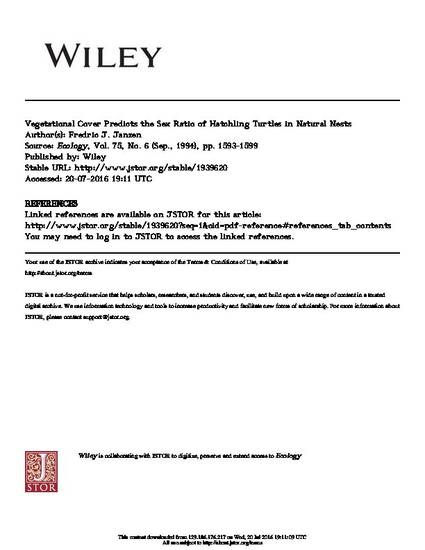
Article
Vegetational Cover Predicts the Sex Ratio of Hatchling Turtles in Natural Nests
Ecology
(1994)
Abstract
I monitored natural nests of an Illinois population of the western painted turtle (Chrysemys picta bellii), a species with temperature—dependent sex determination, for 4 yr to investigate the relationships between vegetational cover at the nest site and hatchling sex ratio. Most nests produced hatchlings all of one sex (66% of 116 nests). Hatchling sex ratio within nests was predictably related to the nesting beach and to the quantity of solar exposure at the nest mainly from the south. The North beach tended to produce more all—male nests and an overall male—biased sex ratio than did the South beach. Within each beach, nests with more vegetational cover on the southern and perhaps western aspects produced more males than did more exposed nests. However, the relationship between solar exposure and nest sex ratio was absent during two atypically cool summers. This study suggests a possible mechanism by which female turtles choose the thermal environment of nests and, hence, the sex ratio of their offspring: they may assess vegetational cover on the nest site at oviposition.
Keywords
- Chrysemys picta,
- hatchlings,
- nests,
- nest-site selection,
- sex determination,
- sex ratio,
- spherical densiometer,
- survivorship,
- temperature,
- turtles
Disciplines
Publication Date
1994
DOI
10.2307/1939620
Publisher Statement
1994 Copyright by the Ecological Society of America
Citation Information
Fredric J. Janzen. "Vegetational Cover Predicts the Sex Ratio of Hatchling Turtles in Natural Nests" Ecology Vol. 76 Iss. 6 (1994) p. 1593 - 1599 Available at: http://works.bepress.com/fredric-janzen/9/
